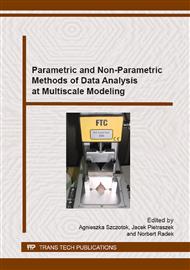[1]
J.E. Gentle, Y. Mori, W.K. Härdle, Handbook of Computational Statistics, Springer-Verlag, Berlin Heidelberg (2012).
Google Scholar
[2]
T.P. Ryan, Modern Experimental Design, John Wiley & Sons, Hoboken, (2007).
Google Scholar
[3]
A.J. Izenman, Modern Multivariate Statistical Techniques. Regression, Classification and Manifold Learning, Springer Science+Business Media, LLC, New York, (2008).
Google Scholar
[4]
I.T. Jolliffe, Principal Component Analysis, Springer, New York, (2010).
Google Scholar
[5]
E. Skrzypczak-Pietraszek, J. Pietraszek, Chemical profile and seasonal variation of phenolic acid content in bastard balm (Melittis melissophyllum L., Lamiaceae), J. Pharm. Biomed. Anal. 66 (2012) 154-161.
DOI: 10.1016/j.jpba.2012.03.037
Google Scholar
[6]
E. Skrzypczak-Pietraszek, J. Pietraszek, Seasonal Changes of Flavonoid Content in Melittis melissophyllum L. (Lamiaceae), Chem. Biodivers. 11/4 (2014) 562-570.
DOI: 10.1002/cbdv.201300148
Google Scholar
[7]
E. Skrzypczak-Pietraszek, J. Slota, J. Pietraszek, The influence of L-phenylalanine, methyl jasmonate and sucrose concentration on the accumulation of phenolic acids in Exacum affine Balf. f. ex Regel shoot culture, Acta Biochim. Pol. 61/1 (2014).
DOI: 10.18388/abp.2014_1922
Google Scholar
[8]
W.H. Kruskal, W.A. Wallis, Use of Ranks in One-Criterion Variance Analysis, J. Am. Stat. Assoc. 47/260 (1952) 583-621.
DOI: 10.1080/01621459.1952.10483441
Google Scholar
[9]
J. Shao, D. Tu, The Jackknife and Bootstrap, Springer, New York, (1995).
Google Scholar
[10]
R. Ulewicz, J. Selejdak, S. Borkowski, M. Jagusiak-Kocik, Process Management in the Cast Iron Foundry, in: Metal 2013, Brno, Czech Republic (2013) 1926-(1931).
Google Scholar
[11]
T. Styrylska, J. Pietraszek, Numerical Modeling of Non-Steady-State Temperature-Fields with Supplementary Data, Z. Angew. Math. Mech. 72/6 (1992) T537-T539.
Google Scholar
[12]
J. Pietraszek, A. Gadek-Moszczak, T. Torunski, Modeling of Errors Counting System for PCB Soldered in the Wave Soldering Technology, Adv. Mater. Res. -Switz. 874 (2014) 139-143.
DOI: 10.4028/www.scientific.net/amr.874.139
Google Scholar
[13]
P. Osocha, Enhancing Safety and Security of Networked FPGA-based Embedded Systems, Adv. Mater. Res. -Switz. 874 (2014) 89-94.
DOI: 10.4028/www.scientific.net/amr.874.89
Google Scholar
[14]
R. Ulewicz, F. Novy, J. Selejdak, Fatigue Strength of Ductile Iron in Ultra-High Cycle Regime, Adv. Mater. Res. -Switz. 874 (2014) 43-48.
DOI: 10.4028/www.scientific.net/amr.874.43
Google Scholar
[15]
F. Deflorian, L. Ciaghi, J. Kazior, Electrochemical Characterization of Vacuum Sintered Copper Alloyed Austenitic Stainless-Steel, Werkst. Korros. 43/9 (1992) 447-452.
DOI: 10.1002/maco.19920430907
Google Scholar
[16]
T. Pieczonka, J. Kazior, A. Tiziani, A. Molinari, Dilatometric study of solid state sintering of austenitic stainless steel, J. Mater. Process. Tech. 64/1-3 (1997) 327-334.
DOI: 10.1016/s0924-0136(96)02583-6
Google Scholar
[17]
A. Szymanska, D. Oleszak, A. Grabias, M. Rosinski, K. Sikorski, J. Kazior, A. Michalski, K.J. Kurzydlowski, Phase transformations in ball milled AISI 316L stainless steel powder and the microstructure of the steel obtained by its sintering, Rev. Adv. Mater. Sci. 8/2 (2004).
Google Scholar
[18]
N. Radek, E. Wajs, M. Luchka, The WC-Co electrospark alloying coatings modified by laser treatment, Powder Metall. Met. C+ 47/3-4 (2008) 197-201.
DOI: 10.1007/s11106-008-9005-7
Google Scholar
[19]
W. Zorawski, R. Chatys, N. Radek, J. Borowiecka-Jamrozek, Plasma-sprayed composite coatings with reduced friction coefficient, Surf. Coat. Tech. 202/18 (2008) 4578-4582.
DOI: 10.1016/j.surfcoat.2008.04.026
Google Scholar
[20]
N. Radek, Determining the Operational Properties of Steel Beaters after Electrospark Deposition, Eksploat Niezawodn (2009) (4) 10-16.
Google Scholar
[21]
B. Weglowski, P. Osocha, Modelling of Creep for Y Pipe from Ferritic-Martensitic P91 Steel, Rynek Energii 6 (2009) 140-145.
Google Scholar
[22]
K. Trzewiczek, A. Szczotok, A. Gadek-Moszczak, Evaluation of the State for The Material of the Live Steam Superheater Pipe Coils of V Degree, Adv. Mater. Res. -Switz. 874 (2014) 35-42.
DOI: 10.4028/www.scientific.net/amr.874.35
Google Scholar
[23]
A. Goroshko, V. Royzman, J. Pietraszek, Construction and practical application of hybrid statistically-determined models of multistage mechanical systems, Mechanika 5 (2014) 489-493.
DOI: 10.5755/j01.mech.20.5.8221
Google Scholar
[24]
J. Pietraszek, Response surface methodology at irregular grids based on Voronoi scheme with neural network approximator, Adv. Soft. Comp. (2003) 250-255.
DOI: 10.1007/978-3-7908-1902-1_35
Google Scholar
[25]
M.J. Chernick, Bootstrap Methods: A Guide for Practitioners and Researchers, John Wiley & Sons, Inc., Hoboken, New Jersey, (2008).
Google Scholar
[26]
J.S. Liu, Monte Carlo Strategies in Scientific Computing, Springer Science+Business Media LLC, New York, (2008).
Google Scholar


